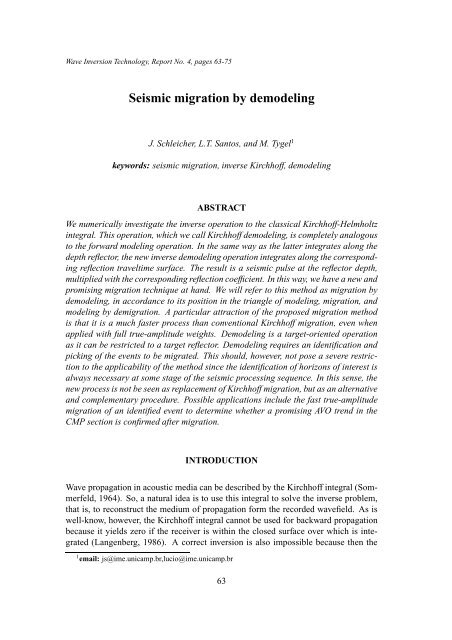Annual Report 2000 - WIT
Annual Report 2000 - WIT
Annual Report 2000 - WIT
You also want an ePaper? Increase the reach of your titles
YUMPU automatically turns print PDFs into web optimized ePapers that Google loves.
Wave Inversion Technology, <strong>Report</strong> No. 4, pages 63-75<br />
Seismic migration by demodeling<br />
J. Schleicher, L.T. Santos, and M. Tygel 1<br />
keywords: seismic migration, inverse Kirchhoff, demodeling<br />
ABSTRACT<br />
We numerically investigate the inverse operation to the classical Kirchhoff-Helmholtz<br />
integral. This operation, which we call Kirchhoff demodeling, is completely analogous<br />
to the forward modeling operation. In the same way as the latter integrates along the<br />
depth reflector, the new inverse demodeling operation integrates along the corresponding<br />
reflection traveltime surface. The result is a seismic pulse at the reflector depth,<br />
multiplied with the corresponding reflection coefficient. In this way, we have a new and<br />
promising migration technique at hand. We will refer to this method as migration by<br />
demodeling, in accordance to its position in the triangle of modeling, migration, and<br />
modeling by demigration. A particular attraction of the proposed migration method<br />
is that it is a much faster process than conventional Kirchhoff migration, even when<br />
applied with full true-amplitude weights. Demodeling is a target-oriented operation<br />
as it can be restricted to a target reflector. Demodeling requires an identification and<br />
picking of the events to be migrated. This should, however, not pose a severe restriction<br />
to the applicability of the method since the identification of horizons of interest is<br />
always necessary at some stage of the seismic processing sequence. In this sense, the<br />
new process is not be seen as replacement of Kirchhoff migration, but as an alternative<br />
and complementary procedure. Possible applications include the fast true-amplitude<br />
migration of an identified event to determine whether a promising AVO trend in the<br />
CMP section is confirmed after migration.<br />
INTRODUCTION<br />
Wave propagation in acoustic media can be described by the Kirchhoff integral (Sommerfeld,<br />
1964). So, a natural idea is to use this integral to solve the inverse problem,<br />
that is, to reconstruct the medium of propagation form the recorded wavefield. As is<br />
well-know, however, the Kirchhoff integral cannot be used for backward propagation<br />
because it yields zero if the receiver is within the closed surface over which is integrated<br />
(Langenberg, 1986). A correct inversion is also impossible because then the<br />
1 email: js@ime.unicamp.br,lucio@ime.unicamp.br<br />
63







